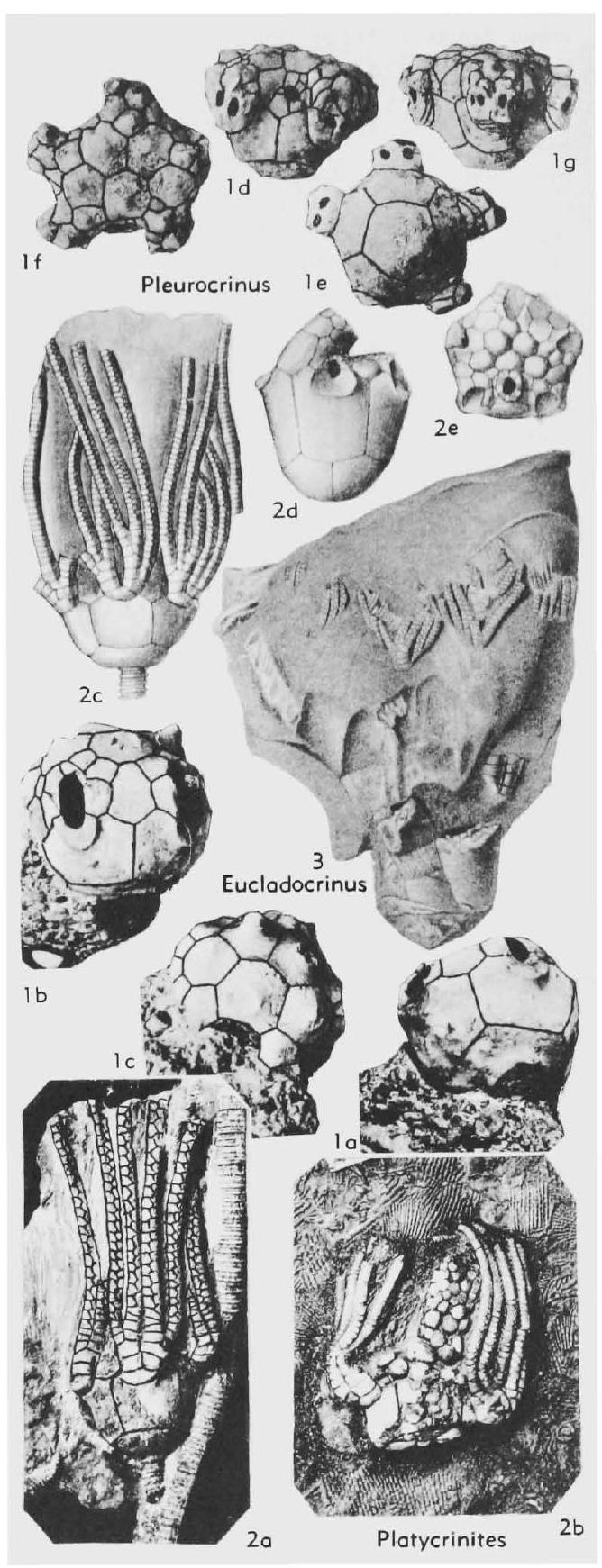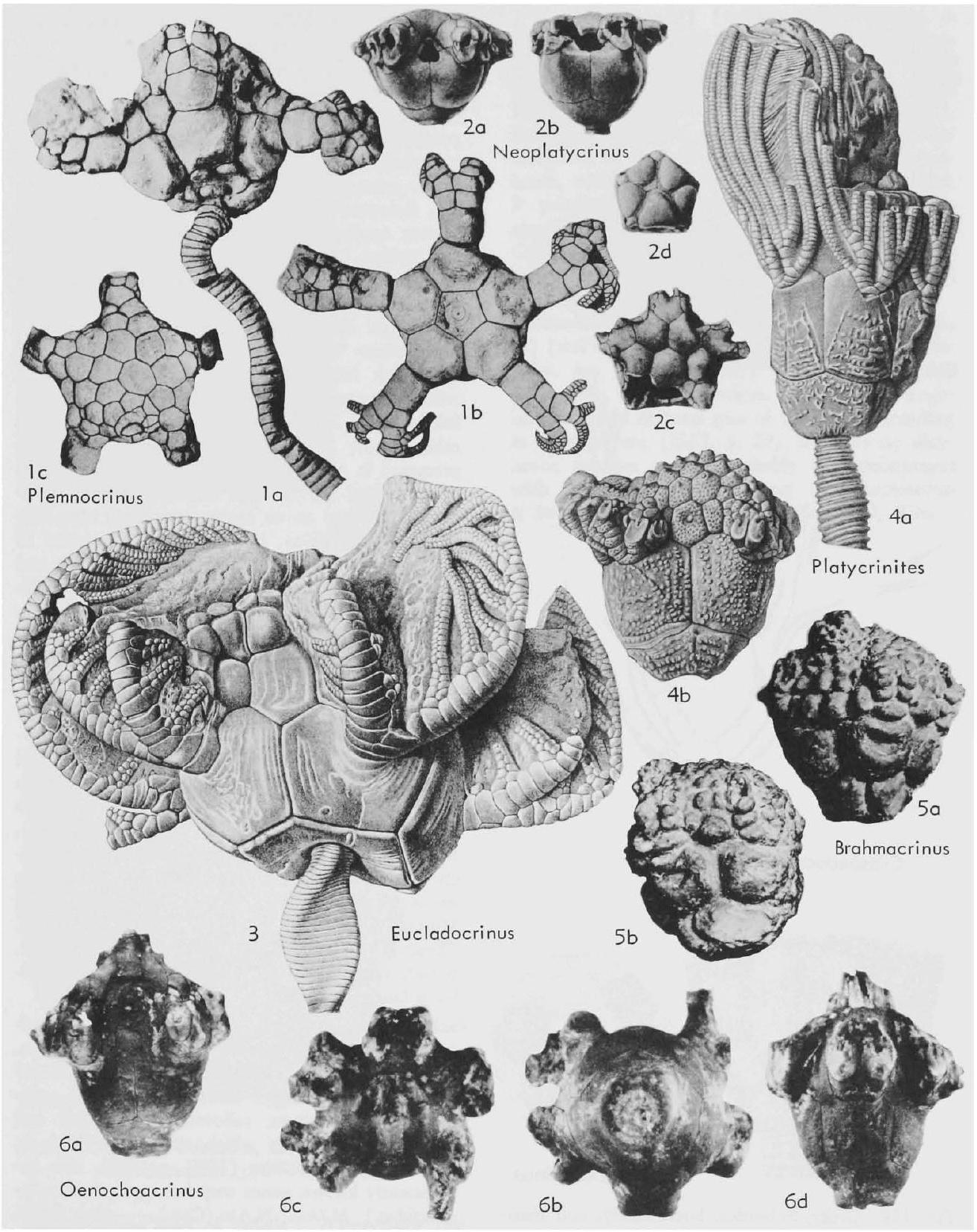Welcome to the Treatise on Invertebrate Paleontology!
Please enter a genera name to retrieve more information.

Platycrinites
Classification
Phylum:
Echinodermata
Subphylum:
Crinozoa
Class:
Crinoidea
Subclass:
Camerata
Order:
Monobathrida
Suborder:
Glyptocrinina
Superfamily:
Platycrinitacea
Family:
Platycrinitidae
Formal Genus Name and Reference:
Platycrinites MILLER, 1821, p. 73
Type Species:
P. laevis, SD Meek & WORTHEN, 1865c, p. 160
Images
(Click to enlarge in a new window)
Fig. 316, 2a, b. *P. laevis, L. Carb., Eng., lat. views of crown and partial crown with anal tube, × 0.9 (Wright, 1955), Fig. 316, 2c-e. P. burlingtonensis (Owen & Shumard), L.Miss. (Osag., Burlington Ls.), USA (Iowa), lat. views of crown and theca, ventral view of theca, × 0.9 (Wachsmuth & Springer, 1897), Fig. 317, 4. P. saffordi (Hall), L.Miss. (Osag., Burlington Ls.), USA (Iowa), 4a, b, lat. views of crown and theca, × 0.7 (Wachsmuth & Springer, 1897)
Synonyms
Platycrinus; Centrocrinus; Atocrimus
Geographic Distribution
Eu.-N.Am.-Indon. (Timor.)
Age Range
Beginning Stage in Treatise Usage:
U.Sil., L.Dev.
Beginning International Stage:
Gorstian
Fraction Up In Beginning Stage:
0
Beginning Date:
426.74
Ending Stage in Treatise Usage:
U.Perm.
Ending International Stage:
Changhsingian
Fraction Up In Ending Stage:
100
Ending Date:
251.9
Description
Calyx bowl shaped, basals 3, unequal, small one typically in AE interray, or fused with others, radials large, with narrow articular facets. Tegmen flat or pyramidal, composed of numerous plates, orals distinct, anal opening excentric, directly through tegmen or at end of short or long anal tube. Arms with primibrachs 1 or rarely 2 axillary, with 1 to 5 higher, heterotomous divisions, becoming biserial above distal axillary of branches, proximal brachials like free arm plates but fixed to tegmen by 1 to 3 interradials.
References
Miller, John Samuel. 1821. A natural history of the Crinoidea or lily-shaped animals, with observations on the genera Asteria, Euryale, Comatula, and Marsupites. C. Frost. Bristol. 150 p., 50 pl.
Museum or Author Information
Classification
Phylum:
Echinodermata
Subphylum:
Crinozoa
Class:
Crinoidea
Subclass:
Camerata
Order:
Monobathrida
Suborder:
Glyptocrinina
Superfamily:
Platycrinitacea
Family:
Platycrinitidae
Formal Genus Name and Reference:
Platycrinites MILLER, 1821, p. 73
Type Species:
P. laevis, SD Meek & WORTHEN, 1865c, p. 160
Images
(Click to enlarge in a new window)
Fig. 316, 2a, b. *P. laevis, L. Carb., Eng., lat. views of crown and partial crown with anal tube, × 0.9 (Wright, 1955), Fig. 316, 2c-e. P. burlingtonensis (Owen & Shumard), L.Miss. (Osag., Burlington Ls.), USA (Iowa), lat. views of crown and theca, ventral view of theca, × 0.9 (Wachsmuth & Springer, 1897), Fig. 317, 4. P. saffordi (Hall), L.Miss. (Osag., Burlington Ls.), USA (Iowa), 4a, b, lat. views of crown and theca, × 0.7 (Wachsmuth & Springer, 1897)
Synonyms
Platycrinus; Centrocrinus; Atocrimus
Geographic Distribution
Eu.-N.Am.-Indon. (Timor.)
Age Range
Beginning Stage in Treatise Usage:
U.Sil., L.Dev.
Beginning International Stage:
Gorstian
Fraction Up In Beginning Stage:
0
Beginning Date:
426.74
Ending Stage in Treatise Usage:
U.Perm.
Ending International Stage:
Changhsingian
Fraction Up In Ending Stage:
100
Ending Date:
251.9
Description
Calyx bowl shaped, basals 3, unequal, small one typically in AE interray, or fused with others, radials large, with narrow articular facets. Tegmen flat or pyramidal, composed of numerous plates, orals distinct, anal opening excentric, directly through tegmen or at end of short or long anal tube. Arms with primibrachs 1 or rarely 2 axillary, with 1 to 5 higher, heterotomous divisions, becoming biserial above distal axillary of branches, proximal brachials like free arm plates but fixed to tegmen by 1 to 3 interradials.
References
Miller, John Samuel. 1821. A natural history of the Crinoidea or lily-shaped animals, with observations on the genera Asteria, Euryale, Comatula, and Marsupites. C. Frost. Bristol. 150 p., 50 pl.

